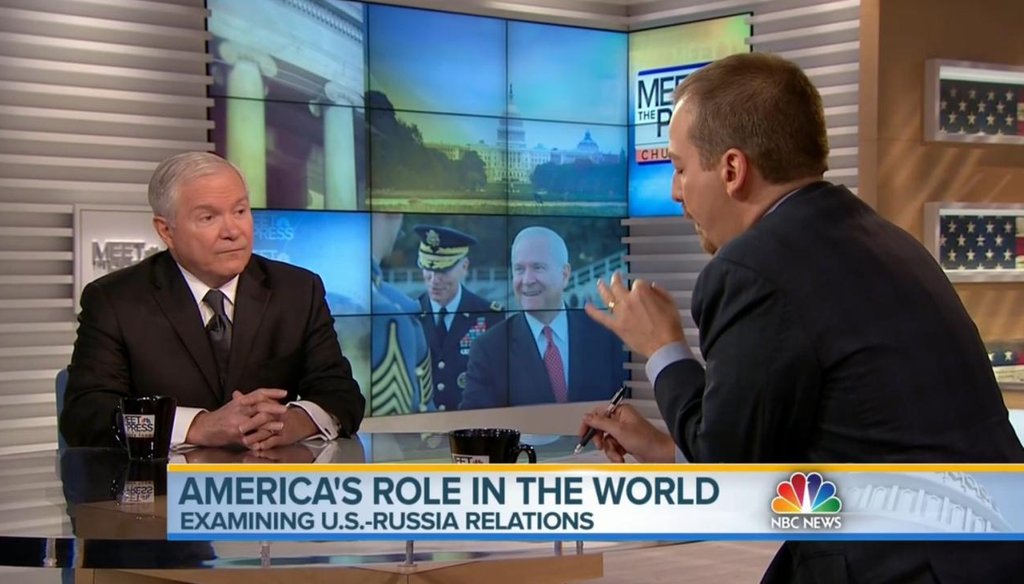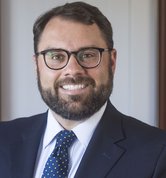Stand up for the facts!
Our only agenda is to publish the truth so you can be an informed participant in democracy.
We need your help.
I would like to contribute

Former Defense Secretary Robert Gates (left) and Chuck Todd on "Meet the Press" Feb. 1, 2015.
Super Sunday brought talk about the spread of terrorists abroad and the spread of measles back home.
PunditFact fact-checked a pair of claims.
On Fox News Sunday, retired Army Gen. Jack Keane discussed the situation in the Middle East with Sen. Kelly Ayotte, R-N.H., and foreign policy expert expert Dennis Ross. Keane made the case that the foreign policy of President Barack Obama is not working, saying that "al-Qaida has grown fourfold in five years."
That’s a significant increase, so we wanted to investigate Keane’s claim further.
Keane is onto something, though he’s using a pretty broad definition of al-Qaida and doing some extrapolating to say the number of terrorists has quadrupled in five years. The claim rates Half True.
Back in the early 2000s, and before 9/11, al-Qaida was generally understood to mean the several hundred people who swore allegiance to Osama bin Laden, said Larry Johnson, a consultant specializing in counterterrorism and a former CIA employee.
Now when people think of al-Qaida, they usually think of a much broader category consisting of that core group, plus affiliates and other Sunni Islamic extremists, such as the Islamic State of Iraq and Syria, located throughout the Middle East, North Africa and the Indian subcontinent.
Under this broad definition, Johnson said Keane’s claim that al-Qaida has grown fourfold since 2010 -- while impossible to verify -- is probably accurate.
"Fourfold is probably an underestimate," added Frederick Kagan, director of the American Enterprise Institute’s Critical Threats project.
However, we don’t have a lot of good information to back the statistic up.
Keane told us his advisers came up with the fact that al-Qaida has increased fourfold by relying on a 2014 report from the think tank RAND. The RAND report found that between 2010 and 2013, the number of Islamic jihadist fighters doubled, and the number of attacks tripled.
Given the continued rise in activity since 2013 and based on discussions with experts, Keane and his advisers concluded that the size of al-Qaida and its affiliates has essentially doubled again since the RAND report was published.
Bruce Hoffman, director of Georgetown University’s Center for Security Studies, said his research has shown that the number of al-Qaida affiliates has more than doubled from eight to 17 since 2008. Adding the Islamic State, once an affiliate, to that count would dramatically increase the number of fighters.
"I can’t pin an exact number to Gen. Keane’s assertion — but it doesn’t sound wildly off base to me," Hoffman said.
On the domestic front, ABC’s This Week discussed the measles outbreak that originated at Disneyland in California and has so far infected at least 84 people in 14 states, according to the Centers for Disease Control and Prevention.
Richard Besser, ABC’s chief health and medical editor, said part of the blame for the outbreak rests with states easing vaccination requirements.
"It used to be that the only children at school who weren't vaccinated were those who had true medical contraindications. They may have an immune problem and couldn't get vaccinated," Besser said. "Now there are 19 states that allow personal belief exemptions. And I think that that is wrong."
We decided to check Besser’s claim that states use to only allow medical exemptions for vaccines but that 19 now permit exemptions for any personal reason. Besser is right in one regard and wrong in the other. We rate his claim Half True.
Documenting the state-by-state situation is a simple task, so we’ll handle that first. Information compiled by the National Conference of State Legislatures, among other sources, backs up Besser’s point.
While there are laws in every state that spell out vaccination requirements for children entering public school, it is easier to avoid them in some states over others. Every state except for Mississippi and West Virginia provides an exemption for religious reasons. Mississippi’s tough vaccination laws result in high immunization rates in its school children.
As Besser said, 19 states also have exemptions for philosophical, personal reasons. They are Arizona, Arkansas, California, Colorado, Idaho, Louisiana, Maine, Michigan, Minnesota, North Dakota, Ohio, Oklahoma, Pennsylvania, Texas, Utah, Vermont, Washington and Wisconsin. Missouri also has an exemption that applies only to daycare, preschool and nursery school.
So Besser’s correct on the number of states now offering personal exemptions. But his claim that there was a time when the only children who weren’t vaccinated had true medical conditions doesn’t ring as true.
The debate about the effectiveness and dangers of vaccination has been raging for at least 50 years. As part of that debate, there have always been exemptions beyond those for medical reasons.
A 1969 report entitled "State laws on compulsory immunization in the United States," which is available through the U.S. National Library of Medicine, does an excellent job of laying out the issue.
In 1969, author Charles L. Jackson reported that only 17 states required measles shots, for instance. And that in most every state, religious exemptions were written into the vaccination laws. Five states, Jackson said, went even further. Missouri, Rhode Island, Michigan, Ohio and Illinois had what Jackson called "voluntary compulsory vaccination."
"Each state has provisions in the statute for exempting children if a parent objects in writing to such requirements for any reason," Jackson wrote.
So 45 years ago, less than half the states required a measles vaccine, and only 26 states required any type of vaccine, according to Jackson.
That changed, of course, over time, and more states began requiring measles vaccines. But they also included exemptions for religious reasons.
What’s the net effect? Vaccinations increased dramatically in the 1970s as new laws came on the books. Joseph A. Califano, the United States secretary of Health, Education, and Welfare from 1977-79, helped lead a push that saw vaccination rates rise from 60 percent to over 90 percent.
By the early 1980s, more than 95 percent of children were completely immunized by the time they entered school.
That number has dipped slightly in recent years. According to the CDC, 92 percent of children 19-35 months old received the measles-mumps-rubella vaccine in 2013, the most recent year available and the highest percentage since 2008.
Federal health officials were content with the national immunization levels but voiced concerns about late first doses, a rise in measles cases not seen since 2000, and slacking coverage in some states.
Our Sources
See individual fact-checks.
















































